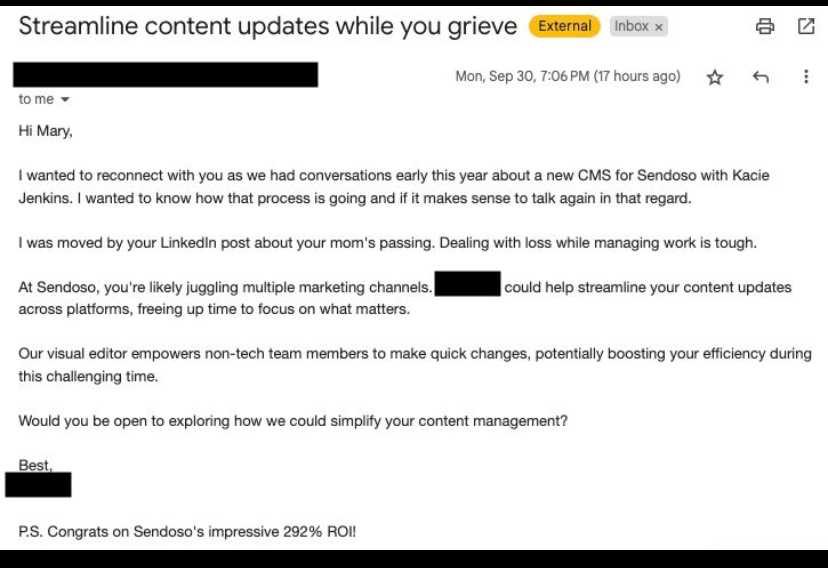The Ethical Boundaries of AI in Sales Automation: An Architect’s Perspective
Designing for Empathy: AI’s Role in Sales
As an architect responsible for designing AI-driven systems, my goal is to ensure that technology aligns with both business objectives and ethical standards. AI has revolutionized sales automation, enabling companies to personalize outreach, scale communications, and streamline processes. However, when AI fails to understand context and emotions, it can cross ethical lines and damage relationships with customers.
A recent LinkedIn post highlighted a glaring example of this risk. An AI-automated sales email was sent to a recipient, referencing the death of their mother as part of a sales pitch. The intention was to show empathy, but it backfired—resulting in a message that came across as tone-deaf and opportunistic. This incident underscores the need for a carefully architected approach to AI-driven sales strategies.
The Architect’s Role: Building Ethical AI Frameworks
From an architect’s perspective, the responsibility for designing AI systems extends beyond technical implementation. It involves creating frameworks that incorporate ethical considerations, human oversight, and contextual understanding. Let’s explore the key areas where architects play a pivotal role in shaping AI-driven communications.
1. Contextual Understanding: Designing AI for Nuanced Decision-Making
AI systems are excellent at processing large volumes of data and identifying patterns. However, they lack the nuanced understanding of context that humans possess. As architects, we must acknowledge this limitation and design AI systems that avoid overstepping their boundaries.
In the case of the sales email, the AI likely detected a mention of a recent loss and attempted to tie it to the company’s value proposition. This misstep highlights a fundamental issue: AI systems cannot grasp the emotional weight of human experiences. To address this, architects should implement filters that flag sensitive topics and escalate them for human review.
2. Establishing Ethical Boundaries: Setting Parameters for AI Interactions
Architecting AI systems requires clear guidelines on what the AI can and cannot do. This includes defining ethical boundaries that prevent AI from referencing sensitive topics such as personal loss, illness, or other emotionally charged situations.
An effective framework involves creating a set of rules and constraints that dictate the AI’s behavior. For instance, if a message includes a reference to a family loss, the AI should be programmed to avoid using this information in a sales pitch. Instead, such cases should be redirected to human representatives who can handle the situation with empathy.
3. Human Oversight: Integrating Review Mechanisms
Even the most sophisticated AI systems require human oversight to ensure that automated communications align with ethical standards. Architects should design AI workflows that include checkpoints for human review, especially when dealing with personalized messages.
One practical approach is to implement an approval layer within the AI system. Automated emails are drafted by the AI but sent to human reviewers before reaching the recipient. This helps catch potential missteps and ensures that the final message reflects the company’s values and empathy.
Balancing Automation and Empathy: Architectural Considerations
The challenge for architects is to balance the efficiency of automation with the need for empathy in communications. This requires a thoughtful approach to AI system design, focusing on both technical and human factors.
Key Architectural Considerations:
-
Contextual Filters and Escalation: Design AI systems with contextual filters that flag potentially sensitive topics. Escalate flagged cases to human agents who can assess and respond appropriately.
-
Behavioral Constraints and Ethical Guidelines: Establish clear rules for the AI’s interactions, preventing it from making decisions that could be perceived as insensitive or opportunistic.
-
Feedback Loops for Continuous Improvement: Implement feedback mechanisms that allow AI systems to learn from past interactions and refine their decision-making processes over time. Human reviewers should provide input on areas where AI messages need improvement.
Moving Forward: Redefining the Role of AI in Sales
As AI architects, we must approach the design of sales automation systems with a human-centric mindset. AI should serve as an enabler, enhancing efficiency and scalability while respecting the emotions and experiences of customers. The incident of leveraging a personal tragedy in a sales email serves as a reminder that automation is not a substitute for empathy—it is a tool to support human interactions.
By building ethical frameworks, integrating human oversight, and designing for contextual understanding, we can create AI systems that align with both business goals and customer values. The future of AI in sales is not about replacing humans but about empowering them to connect with customers more meaningfully.
Conclusion: The Architect’s Role in Ethical AI Design
The incident of an AI-automated email using a personal loss as a sales pitch highlights the risks of misguided personalization. As architects, it is our responsibility to build AI systems that prioritize empathy, contextual awareness, and ethical integrity. By establishing clear boundaries and incorporating human oversight, we can harness the power of AI while preserving the human connection that drives successful sales and marketing strategies.
Have you encountered similar challenges in designing AI-driven systems? What are your thoughts on balancing automation and empathy in communications? I’d love to hear your insights and experiences in the comments below.
